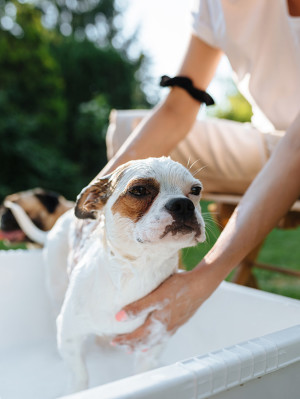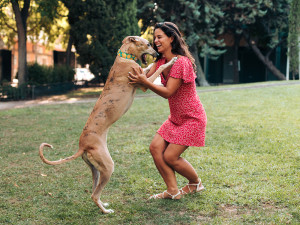Why Is Your Young Dog Going Gray?
And why stress could be to blame. Your spoiled baby, stressed? Unfortunately, yes.
We know that premature gray hair in people is a result of a variety of influences, and it’s fair to point accusing fingers at an obvious one: stress. Before-and-after pictures of U.S. presidents show an astounding increase in gray hair in eight — or even four — years. Many parents swear their kids are making them go gray.
My husband has solid evidence that the stress of parenting is the cause of gray hairs. His identical twin brother, who became a parent a few years before my husband did, started going gray soon after his kids were born. My husband also went gray soon after our kids were born. Yeah, that can’t be a coincidence. A 2016 study on premature graying in dogs opens in new tab suggests that stress is a factor in our canine best friends, too.
Snap a pic of your pup’s teeth, and GREENIES™ will help you spot potential signs of oral health issues.
The study on premature graying and stress in dogs
The study was of 400 dogs in the age range of one to four years who were recruited with flyers at veterinary clinics, dog shows, and dog parks. Each dog was photographed from the front and from the side so that researchers could assess the degree of graying on the pups’ muzzles.
They were scored as follows: Zero equals no gray; one equals frontal gray; two equals half gray; and three equals full gray. Additionally, their parents filled out a 42-question survey. From there, researchers collected data on anxious behaviors, impulsive behaviors, fears, size, age, sex, number of dogs and cats in the household, time spent unsupervised outdoors, whether they were spayed or neutered, medical issues, and participation in organized sports or activities.
How much do you spend on your pet per year?
Researchers found an association between graying on the muzzle and anxious behaviors, impulse behaviors, and fear of loud noises, unfamiliar people, and unfamiliar dogs. The extent of grayness was positively correlated with age, and female dogs were more gray than male dogs. There was no link found with size, being spayed or neutered, medical problems (which were rare in the sample), reactions to thunderstorms, fear of unfamiliar places, number of dogs or cats in the household, time spent outside unsupervised, or being involved in organized activities.
Dogs were only included in the study if it was possible to determine how gray their muzzles were. (White dogs and those with merle coloring didn’t make the cut, causing 43 dogs to be excluded from the study.) The people who evaluated the photographs were not the same people who had any knowledge of the questionnaires, which prevents accidental bias in the assessment of the degree of graying. The survey was designed so that pet parents were unaware of the purpose of the study; they were simply told it was about dog lifestyle.
How this info helps our stressed pups
This research adds to our understanding of premature graying in dogs, and what’s most exciting about that is the possibilities it opens for helping dogs. Being anxious or fearful and struggling with impulse control are hard on dogs, and any help dogs receive for these issues can be beneficial.
If behaviorists, veterinarians, trainers, and other dog professionals know that a gray muzzle in a young dog may indicate that the dog suffers from these issues, perhaps they will more thoroughly assess them or refer them to other people for evaluation. It’s just another way that people can potentially make life better and easier for many dogs.
It’s important that practitioners avoid jumping to the conclusion that a prematurely graying dog is necessarily stressed, fearful, or has issues with impulsivity. Although these issues should be explored, they may not explain the gray hair because other factors may be at play.
Other reasons dogs go gray
One genetic cause of going gray is the not-so-creatively named “graying gene.” The specifics of this gene have not been well-studied, but we do know that dogs expressing this gene have fur that gradually fades to gray. Dog fur color comes from two different types of melaninopens in new tab: eumelanin, which gives fur black or brown coloring, and phaeomelanin, which gives fur shades of red or yellow coloring.
The graying gene primarily affects eumelanin with only limited effects on phaeomelanin. Dogs who are gray because of the graying gene are born with full coloration, but gradually fade. New hairs are fully colored, but the color fades as it grows out. The hair tends to be darkest at the base but lighter towards the tips.
Because the fading is progressive, these gray dogs tend to be dogs with long, continuously growing fur, such as wiry and curly coated dogs. Short-haired dogs, even if they have this graying gene, usually shed hairs before they have an opportunity to fade to gray. Black masks on dogs in which at least the muzzle — and sometimes the tips of the ears, the whole ears and the face are also dark — are not affected by the gradual graying gene even though the coloration comes from eumelanin.
So, dogs with the graying gene may be gray on most of their body but dark on the face, which is the opposite of the dogs who are going gray because of stress. This gradual-graying gene is more common in some breeds than others. Breeds known for this gradual graying include Poodles, Bedlington Terriers, Dandie Dinmont Terriers, Irish Wolfhounds, Bearded Collies, and Havanese.
Other health issues that are to blame
Disease can cause premature graying of the fur. There is evidence that thyroid issues, liver disease, and kidney disease may all be associated with going gray early. A skin condition called vitiligo can cause a loss of pigment in patches on the face and body, leading to light fur in areas where it used to be darker. It may be an autoimmune disorder, and it’s possible that it has a genetic basis. There are other case studies of dogs going gray or white because of autoimmune issues that cause the body to attack its own melanocytes — the cells that produce melanin.
Dogs going gray at an early age may have health issues and need to see a vet. They may also have behavioral issues and need a behaviorist’s help, or they may just be a dog with adorable spectacles before their time.
References:
Eumelanin and Phaeomelanin Contents of Human Epidermis and Cultured Melanocytesopens in new tab













